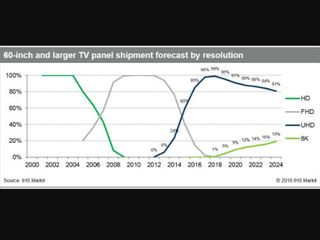2018 to Mark Starting Point for 8K Displays: IHS Markit

The first uses of 8K displays will get underway in 2018, though the bulk of TV panel manufacturing will be focused on 4K/Ultra HD this year, according to a new forecast from IHS Markit.
The research firm predicts that just 1% of displays in the 60-inch and larger category will support 7680 x 4320 pixel resolution in 2018, and climb to 9% in 2020, and reach 19% by 2024. As a point of comparison, 4K/UHD panels accounted for more than 98% of displays that are 60 inches and larger in 2017, but will dip to 81% by 2024, IHS Markit found in its new Display Long-Term Demand Forecast Tracker.
“As UHD has rapidly replaced full HD in the super large-sized TV display market, panel makers are willing to supply differentiated products with higher resolution and improve profit margin with premium products,” Ricky Park, director at IHS Markit, said in a statement. “Year 2018 will become the first year of the 8K resolution TV display.”
The research notes that Innolux started developing 8K panels in 2017, and produced its first 8K LCD TV display (60Hz, 65-inch) in Q4 2017, which will be supplied to Sharp and to Chinese TV makers in the start. Sharp also mass-produced its first 8K LCD TV display, a 70-inch model, in Q4 2017 to support the Sharp TV brand in China, IHS Markit pointed out, adding that Samsung and Sony also plan to release “flagship” 8K TV models later this year, and will “consume almost all” 120Hz 8K panels from Innolux, AUO and Samsung Display, with sizes ranging from 65 inches to 85 inches.
LG Display also introduced an 88-inch 8K OLED TV display this week at CES in Las Vegas.
The HDMI Forum and the HDMI Licensing Authority are likewise preparing for the 8K era with HDMI 2.1, a new spec for connectors and cables (released on Nov. 28, 2017) that will support resolutions up to 10K, data rates of 48 Gbps, as well as Dynamic HDR and other advanced features.
RELATED: HDMI 2.1 Targets Resolutions of up to 10K
Multichannel Newsletter
The smarter way to stay on top of the multichannel video marketplace. Sign up below.
“This year, you’re actually going to see some commercial products” supporting 8K, Rob Tobias, president of HDMI LA, said at a press event XX at CES that provided an update on HDMI 2.1 efforts. He noted that the move to 8K will be driven in part by video productions being planned for the 2020 Summer Olympics in Tokyo and the 2022 Winter Games to be hosted in Beijing.
Looking beyond resolution, he said Dynamic HDR, which will enable “ideal values” in areas such as depth, brightness, contrast and wider color gamuts on a scene-by-scene or even a frame-by-frame basis (rather than being applied statically to the entire video asset), “pops the image off the screen.”
Tobias also predicted that Dynamic HDR will emerge as “one of the standout technologies that consumers can really grasp and see,” while HDMI 2.1’s use of variable refresh rate and a low-latency model will deliver a better experience for gamers.
He said the new spec’s support for eARC (enhanced Audio Return Channel), which enables up to 32-channel and object-based audio, will also be key as consumers desire both picture and sound to complete the “home theater experience.”
Cris Pasqualino, chairman of the HDMI Forum, said alter that implementing compliance testing for all elements of HDMI 2.1 is a “top priority.”
Those elements will come way of a staged rollout. “It’s a very deep spec,” he said, adding that some initial components tied to compliance testing should be expected by Q2 2018.
